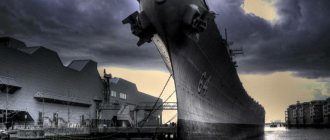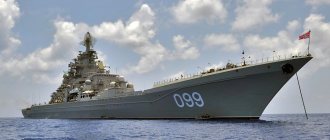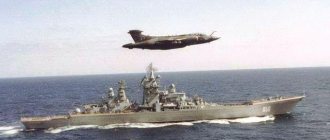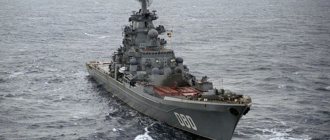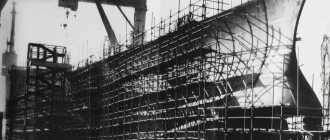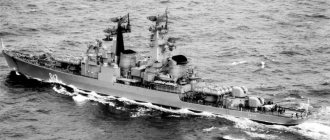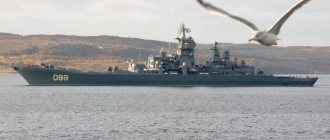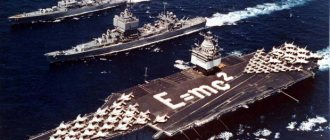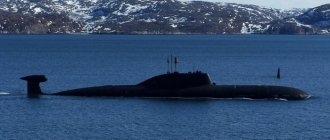Will the enemy sink our SSBNs along with nuclear weapons with a preemptive strike?
Many people express concern: our strategic submarine cruisers (SSBNs) are inferior to American submarines in terms of acoustic equipment capabilities. Therefore, the enemy can finish them off with a pre-emptive strike, sending part of the Russian strategic triad to the bottom. However, the combat stability of our SSBNs can be ensured by consistently implementing the provisions of the new edition of the “Fundamentals of State Policy in the Field of Nuclear Deterrence.”
The provision introduced into the “Fundamentals” on the possibility of switching to the use of nuclear weapons after the destruction of a critically important facility or important element of the strategic nuclear forces, which in particular is any of our SSBNs, may force potential adversaries to abandon military operations to search for and destroy our ballistic missile submarines .
How were they built?
This is the second serial missile carrier built according to project 955 "Borey-A" of the St. Petersburg Central Design Bureau "Rubin". The ship was laid down at the shipyard on December 26, 2014. The main hull of the ship will be formed by the end of 2015. The ceremony for the withdrawal of the cruiser Generalissimo Suvorov from the Sevmash boathouse took place on December 25, 2021. At the beginning of 2022, the missile carrier was launched, where it awaits completion at the pier. In the fall, the ship will begin performing complex mooring and factory sea trials at sea, and then a full cycle of state tests. The missile carrier will probably be delivered to the customer in the first half of 2023.
Launching of the nuclear missile carrier Generalissimo Suvorov. Photo: Still from YouTube
Examples[edit]
| Name | Nation | Surface offset | Subsea displacement | Speed | Pistols | Torpedo tubes | Crew | Year | Reference |
| Ettore Fieramosca | Kingdom of Italy | 1530 tons | 2094 tons | 15 kn (28 km/h; 17 mph) | 1 × 12 cm (4.7 in) 45 cal. | 14 | 78 | 1929 | |
| Surcouf | France | 3250 tons | 4,304 tons | 18 kn (33 km/h; 21 mph) | 2 × 203 mm (8 in) 50 cal. | 10 [4] | 118 | 1934 | [5] |
| Narwhal -class | USA | 2730 tons | 4050 tons | 17 kn (31 km/h; 20 mph) | 2 × 6 inches / 53 cal. | 6 | 90 | 1928 | [6] |
| Type U-139 | Germany | 1930 tons | 2483 tons | 15 kn (28 km/h; 17 mph) | 2 × 15 cm (5.9 in) | 6 | 62 | 1916 | [7] |
| Type U-151 | Germany | 1512 tons | 1875 tons | 12 kn (22 km/h; 14 mph) | 2 × 15 cm (5.9 in) | 6 | 56 | 1917 | [7] |
| Type J1 | Japan | 2135 tons | 2791 tons | 18 kn (33 km/h; 21 mph) | 2 × 14 cm (5.5 in) / 40 cal. | 6 | 80 | 1926 | [8] |
| Type B1 | Japan | 2,584 tons | 3654 tons | 23 kn (43 km/h; 26 mph) | 1 × 14 cm (5.5 in) / 40 gauge | 6 | 100 | 1940 | [9] |
| Type AM | Japan | 3603 tons | 4762 tons | 16 kn (30 km/h; 18 mph) | 1 × 14 cm (5.5 in) / 40 gauge | 6 | 100 | 1944 | [10] |
| HMS X1 | Royal Navy | 2780 tons | 3600 tons | 19 kn (35 km/h; 22 mph) | 4 × 5.2 inches (13 cm) | 6 | 110 | 1923 | [11] |
| Kaidai class | Japan | 1833 tons | 2602 tons | 23 kn (43 km/h; 26 mph) | 1 × 12 cm (4.7 in) | 6 | 80 | 1930 | [12] |
| K-class | Soviet Union | 1490 tons | 2104 tons | 22.5 kn (41.7 km/h; 25.9 mph) | 2 × 10 cm (3.9 in) | 10 | 67 | 1939 | [13] |
| Type IXD2 | Germany | 1616 tons | 1804 tons | 19 kn (35 km/h; 22 mph) | 1 × 10.5 cm (4.1 in) | 6 | 57 | 1938 | [13] |
| Kanyi class | Italy | 1461 tons | 2136 tons | 18 kn (33 km/h; 21 mph) | 2 × 10 cm (3.9 in) | 14 | 85 | 1940 | [14] |
What will he be armed with?
The strategic nuclear submarine Generalissimo Suvorov is equipped with sixteen Bulava intercontinental ballistic missiles. In addition to the new sea-based ICBM, capable of carrying from 6 to 10 individually targeted nuclear units with the ability to maneuver in pitch and yaw, it is also armed with eight bow torpedo tubes of 533 mm caliber and six disposable non-rechargeable Barrier launchers for launching hydroacoustic countermeasures against MG- 104 "Throw" or MG-114 "Beryl".
Design of strategic nuclear submarine cruisers Project 667B "Murena"
Design of Project 667B Murena submarine missile cruisers
The design of submarines of the Project 667B Murena type generally repeated the design of its predecessor Project 667A Navaga. The double-hulled ship, of slightly increased length compared to Project 667A, had a durable hull divided into 10 waterproof compartments. Due to the greater length of the missiles, the fairing of the missile silos became taller, and the silhouette of the boat acquired a characteristic “hump” - a pronounced identifying feature of boats of Project 667B and later modifications.
Main power plant with a capacity of 52,000 hp. With. included two VM-4B water-water reactors and two OK-700 steam turbines with GTZA-635 turbo-gear units. There were two DG-460 diesel generators and two economical electric motors (2 x 260 hp). To reduce the hydroacoustic signature of the ship, a two-stage damping of the vibration-active mechanisms of the steam turbine plant was introduced.
The submarine received a new Tobol-B navigation complex, which includes the equipment of the Cyclone-B space navigation system and provides all the initial data for preparing and launching missiles.
Radio communications are integrated into a single complex. The ship was the first to receive the Molniya-1 automatic space communications system. As on the Project 667A boats, the Kerch hydroacoustic complex was installed on the new nuclear-powered vessel.
The ship received a new combat information control system. For the first time on domestic submarines on Project 667B, an autonomous shipborne digital computer system was used to control missile weapons, solving missile firing problems. The entire submarine's missile ammunition could be fired in one salvo.
The D-9 missile system included 12 two-stage liquid-fueled ampuled missiles R-29 (4K75, RSM-40, Western designation - SS-N-8) with a maximum firing range of up to 7800 km.
“Moray eels” of Project 667B were equipped with the Voskhod combat information and control system with the ship’s digital computer system “Alpha”, which solves shooting tasks. For the first time in the world, and specifically for Project 667B “Moray”, the first system for protecting missiles from unauthorized actions was created, ensuring that the launch was carried out only after receiving an order from the Supreme Command.
Drawing of the underwater nuclear missile cruiser Project 667B "Murena".
Design of the R-29 missiles of the D-9 missile system
The R-29 ballistic missile was made on the same technical principles as the R-27 type missile that preceded it. However, on the R-29, the second stage engine was recessed into the first stage oxidizer tank, which made it possible to create a very compact design, and the on-board equipment of the rocket control system, for the first time in the world naval rocket industry, included a digital computer.
To ensure the necessary accuracy with an increased firing range, the inertial missile control system (also a world first) was supplemented with a system for correcting the flight plane based on stellar landmarks. The probable circular deviation of the R-29 missile was 1.5 km.
The R-29 also became the first domestic naval missile equipped with means to overcome enemy missile defenses. When folded, light decoys were placed in special cylindrical containers welded into the second stage fuel tank.
The length of the R-29 ballistic missile was 13.435 m, the body diameter was 1.8 m, the launch weight was 33.3 tons, the throw weight was 1.1 tons, and the warhead power was 1 megaton. The production of missiles was carried out by the Krasnoyarsk Machine-Building Plant in cooperation with other enterprises in Siberia.
The launch of missiles from submarines of the 667B Murena type could be carried out from an underwater position from a depth of 55 m at a boat speed of up to 5 knots and a sea state of up to 6 points, either in a salvo of the entire ammunition load or with single missiles. Missile firing was allowed both from underwater and from the surface, while the ship was in the base. Pre-launch preparation and production of the launch itself were carried out automatically. If for the D-5 complex the latitude of the launch point was limited to 85°, then the D-9 became the world's first all-latitude missile system.
R-29 ballistic missile for Project 667B Murena submarines. As can be seen from the photograph, the dimensions of the rocket are not small
Description
The missile carrier belongs to the fourth generation of nuclear submarines of the improved Borei-A project (designed by the St. Petersburg Central Design Bureau of Marine Equipment "Rubin"). The project implemented fundamentally new technical solutions, improved equipment, reduced the level of physical fields, increased safety, and carried out a range of import substitution works. A distinctive feature of the new Borei-A missile carriers is that their construction does not use backlogs from previous nuclear submarine models, such as Shchuka-B or Antey, which allows the full potential of the 4th generation SSBNs to be fully revealed.
The submarine is named after the great Russian commander Alexander Vasilyevich Suvorov . The combat characteristics of this boat are comparable to the performance characteristics of the Columbia-class submarines that have not yet been laid down in the United States, the cost of which is 14 times higher than the cost of building our boat and amounts to 6.2 billion dollars per unit.
The displacement is 24 thousand tons.
Synchronized swimming. Two fourth-generation nuclear submarines were handed over to the Navy More details
Multifunctional "Calibers"
A separate topic for discussion among foreign analysts is the most powerful weapons. Various military analytical publications almost weekly publish materials reviewing deadly missiles. “Caliber” deserves special compliments.
wikipedia.org / Vitaly V. Kuzmin / vitalykuzmin.net / CC BY-SA 4.0
This is the type of weapon that is in the arsenal of many submarines, in addition to Antey, which also does not please NATO. For example, The National Interest portal has repeatedly published materials about Caliber, telling why the enemies of the Russian Federation are so afraid of them. As analysts emphasize, missiles, if launched from a ship, fly at low altitude and cannot be detected by radar. Accordingly, opponents will not be able to react to the launch in time.
These missiles fly at low altitude above the sea surface, invisible to enemy radars. The ship-launched version of the missile has the advantage of thrust vectoring via a rotating nozzle, and active radar homing Kalibr missiles are also designed to perform evasive maneuvers instead of approaching the target in a straight line. Flying a short distance towards an enemy ship, such a missile accelerates from a cruising speed of M=0.8 to M=3 and descends, continuing its flight at an altitude of only 4.6 meters. Because of this, it is extremely difficult for shipborne anti-missile systems to detect and hit a Russian missile, experts noted in one of the materials.
Today, missiles can be carried by ships (for example, the Gepard-class patrol vessel), as well as submarines, including Halibut, Yasen and Varshavyanka. The missiles are considered the most powerful of their type in existence.
Project "Borey-A"
Project 955 "Borey" is a series of Russian strategic nuclear submarines of the 4th generation, armed with 16 R-30 "Bulava" SLBMs. In total, 10 ships are planned to be built (3 Borei projects and 7 Borei-A projects), 5 ships have been built by December 2022 (5 in the fleet), 5 are under construction. The lead ship of the Borey-A project, Prince Vladimir, was built at JSC PA Sevmash and transferred to the fleet on June 12, 2022. The first serial missile carrier "Prince Oleg" was transferred to the Navy on December 21, 2022.
https://murmansk.ru/18440
Answer to the American "Harpoon"
The supersonic anti-ship Onyxes have not escaped the attention of experts. As analysts write, the missile was developed in response to the American UGM-84 Harpoon, but ultimately surpassed its competitor.
wikipedia.org / Boevaya mashina / CC BY-SA 4.0
The weapon has a number of advantages: invisibility for enemy air defenses, the ability to operate in conditions where signals are jammed by electronic warfare. Bad weather conditions are also no problem. Onyx, like Kalibr, can easily be placed on powerful Russian submarines.
We can say that the Onyx-M heavy hypersonic long-range anti-ship missile will make Americans not only afraid, but in awe of the power of the Russian army’s anti-ship weapons, according to Chinese military experts.
Designers and politics
First Secretary of the CPSU Central Committee N.S.
Khrushchev believed in missiles, especially intercontinental missiles, and missile submarines. Following this belief, he reduced the army and navy and ordered unfinished cruisers to be melted down. He reasoned simply - and subsequently recorded these thoughts in his memoirs: “Now it will be difficult for the surface fleet to survive in the event of war. The cruiser cannot act alone. But a submarine can, it doesn’t need cover. If we take the firepower of a cruiser and compare it with a submarine with missiles, then the latter will win. It can swim to the required distance and fire even at a target in the interior of the country. A boat, which costs many times less than a cruiser and has a smaller crew, acquires greater firepower and also has the ability to travel hidden. In addition, the underwater flog received nuclear fuel engines, after which it could remain under dopa for virtually unlimited time. That is why we decided to build primarily a submarine fleet, putting its creation on an assembly line. The goal is to create a powerful fleet with which we could threaten the enemy on all oceans. The main enemy is the USA. They need to cover a long distance to get to Europe, transport troops here, and supply their troops with weapons and supplies. Therefore, they cannot escape the water. This is where the submarine fleet is especially important for us.” Two designers created missiles for Soviet submarines. Ballistic - V.P. Makeev (SKB-385, today - State Missile, Miass, Chelyabinsk region), winged - V, N. Chelomey (OKB-52, today - NPO Mashinostroeniya, Reutov, Moscow region). Khrushchev especially singled out the latter. Chelomey was ten years older than Makeev; he combined outstanding talent as a scientist and designer, strong character and experience as a politician. What is also important, Khrushchev’s son, Sergei Nikitovich, worked for him for ten years. Chelomey had great influence on the first person in the state and, taking advantage of this, energetically and quite successfully promoted his idea of arming submarines with cruise missiles. In 1959, diesel submarines Project 644 appeared, armed with P5 cruise missiles with a range of 500 km, marking the beginning of a new subclass of boats - attack boats.
The Cuban Missile Crisis (October 1962), caused by the deployment of Soviet medium-range missiles with tactical nuclear warheads in Cuba, brought the world to the brink of a nuclear conflict. This was the peak of the Cold War.
At this time, accident after accident occurred on missile boats pr. 658 already delivered to the fleet. “It was literally a disaster,” recalls S. N. Kovalev, “steam generators were leaking, refrigerators were leaking, and practically the combat readiness of these boats was in question.” Only the boat of captain 2nd rank V.L. Berezovsky (later the first commander of the lead missile carrier of Project 667A - K-137, rear admiral, Hero of the Soviet Union) was ready for the campaign. We went to one of the bays, loaded ourselves with three nuclear missiles and stood with the launcher “started”, waiting for the order,” recalls Vadim Leonidovich, “readiness number two: on the mooring lines, but not a single person came to the pier. There was no order. We don’t know why.”
According to Berezovsky, the campaign was still doomed to failure:
“Preparing for the rocket launch took a lot of time - ascent, observation, calming the compasses - about an hour twenty to an hour thirty. This is a monstrously long time, especially for a surface position. The boat would have been accurately detected, even before surfacing.”
...The lead ship of Project 667A was laid down two years after these events - November 4, 1964. The boat was equipped with 1-6 silos for ballistic missiles developed at the V.P. Makeev Design Bureau. True, no one knew what type of rockets - liquid or solid fuel - would be used.
Nuclear submarine 885 type "Ash"
Today, the SSGN Severodvinsk is the only operational submarine of this class. On June 17 last year, a ceremonial flag raising took place on K-560. Over the next 5 years, it is planned to create and launch 7 more such vessels. The construction of the Kazan, Krasnoyarsk and Novosibirsk submarines is already in full swing. If “Severodvinsk” is a project 885, then the remaining boats will be created according to the project of an improved modification 885M.
As for weapons, the Yasen nuclear submarines will be equipped with supersonic cruise missiles of the Caliber type. The firing range of these missiles can be 2.5 thousand km, and they are high-precision projectiles whose main task will be the destruction of enemy aircraft carriers. It is also planned that the Kazan nuclear submarine will be equipped with fundamentally new equipment that has not previously been used in the development of underwater vehicles. Moreover, due to a number of technical characteristics, primarily due to the minimal noise level, detecting such a submarine will be very problematic. In addition, this multi-purpose submarine will be a worthy competitor to the American SSN575 Seawolf.
At the end of November 2012, tests of the Caliber missile system were carried out. The shooting was carried out from the submerged Severodvinsk submarine at ground targets from a distance of 1.4 thousand km. In addition, a supersonic Onyx-type rocket was launched. The missile launches were successful and proved the feasibility of their use.
"Ohio"
Nuclear-powered nuclear submarines, which form the backbone of the United States nuclear forces. The Ohio series includes 18 submarines. They are capable of carrying out a sudden massive attack with the missiles on board. In the 50s of the 20th century, America planned to inflict significant damage on strategic targets of the Soviet Union.
Peculiarities:
- 4 torpedo launchers;
- 24 ballistic missiles for 14 submarines;
- 154 cruise missiles for 4 submarines;
- hull length - 170.7 m;
- navigation autonomy - 70 days;
- underwater speed - 25 knots;
- destruction range - 9-12 thousand km.
Thanks to the presence of a light, streamlined superstructure covering the hull of ships, hydrodynamic noise levels are reduced, especially at high speeds. The Ohio submarines are based on the coasts of the Pacific and Atlantic oceans. Nuclear submarines of this type have the most missile launchers and are the quietest.
Notes[edit]
- ^ ab Blair, page 501
- Tarrant, pp.44-60
- Lenton, pp.198 & 199
- ^
The Avalanch Press page on Sucouf says there are 8 outer tubes (2x4), apparently one 55cm and 40cm (1x4 each), but doesn't say how many there are in the body. - Le Masson, p.157
- ↑
Silverstone, p.186 - ^ab Gray, p.227
- ↑
Watt, p.167 - Tue, p.185
- Watts, p.200
- Lenton & Secondary Specialized, p.136
- ↑
Watt, p.188 - ^ab Taylor, p.104
- Kafka & Pepperburg, p.790
